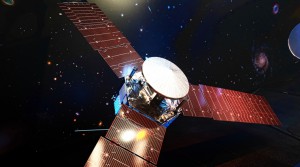by Guido Francesco Guida
Jupiter dominates the evening sky January through July this year. In the mean time we are going to celebrate NASA’s Juno spacecraft. It was launched from Cape Canaveral Air Force Station on August 5, 2011 and, on the 4th of July, it has finally entered Jupiter’s orbit after a five year journey.

“It’s a milestone for planetary science,” NASA Director of Planetary Science Jim Green said at a news conference, adding that the Juno mission should provide far more data than has been gleaned from fly-by trips past the gas giant. Juno is planned to orbit Jupiter 37 times over the next 20 months as it can provide new information about the gas giant’s core and composition. It also will take the first pictures of Jupiter’s polar regions and study the huge aurora that lights up Jupiter’s north and south poles.
Since It takes about 48 minutes to send a radio signal to Jupiter, and the same time to send one back. If there is an issue, NASA will hear about it an hour later, and by that time it will be way too late for the space agency to send any corrective signals from Earth. This is why the Juno mission team has programmed the spacecraft with ways to restart itself if something stops the engine burn. If all goes well, the burn will put Juno into a 53-day orbit around the planet.
Jupiter is the fifth planet from the Sun and the largest in the Solar System. It is a giant planet with a mass one-thousandth that of the Sun, but two and a half times that of all the other planets in the Solar System combined.
Jupiter is a giant gas planet and is like a star in composition. Its atmosphere is made up of mostly hydrogen gas and helium gas. The planet’s surface is covered in thick red, brown, yellow and white clouds. If it had been about 80 times more massive, it would have become a star rather than a planet. Jupiter has three thin rings and an extremely powerful magnetic field, like a giant magnet. It has 62 known moons. The planet’s four largest moons are Io, Europa, Ganymede (the largest moon in the solar system) and Callisto.
Watching from the Earth, on July 9th, the moon and Jupiter again appear close to one another. Than it will get lost to view and will reappear in the morning skies in October 2016.
Through binoculars we can see high-contrast cloud features on Jupiter and the four Galilean moons. Through a telescope we can see the Great Red Spot when it faces Earth. These features have been observed by astronomers for many centuries. In 1667 Giovanni Domenico Cassini observed a great spot on Jupiter, which he called “The Permanent Spot” and many cloud bands. Earlier that century, Galileo observed four moons of Jupiter over several weeks in 1610, and charted their movement around the planet.
Picture source: ibtimes.co.uk, nasa.gov, setterfield.org, sci-news.com,planetsedu.com, hdwaalpaersct.com, w41k.com


If future observations by Juno confirm the existence of water on Jupiter and map it in detail, that knowledge could potentially be used to help determine if there’s water on other gas-giant planets.